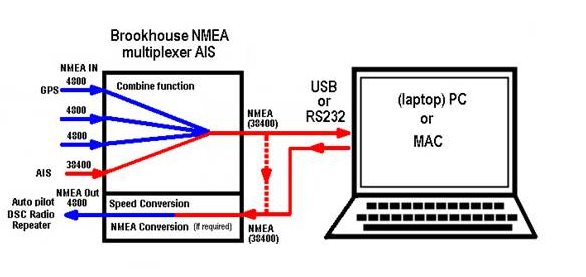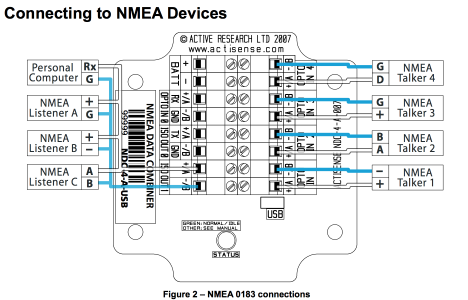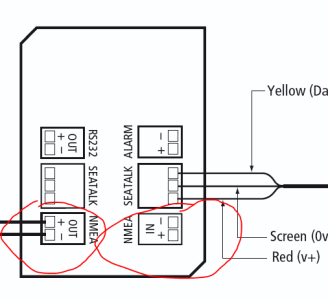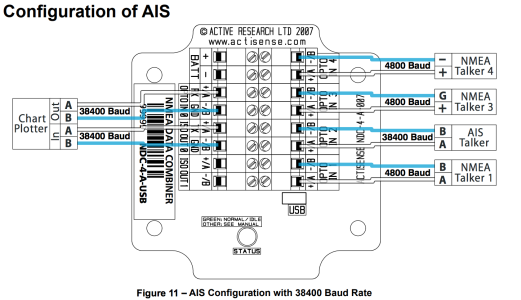You are using an out of date browser. It may not display this or other websites correctly.
You should upgrade or use an alternative browser.
You should upgrade or use an alternative browser.
Navnet 2 Port 4 to Seatalk
- Thread starter MyronB
- Start date
Good afternoon MyronB,
Thank you for your inquiry and question. Unlike other forums where there is plenty of end user feedback this forum is usually supported by Furuno employees and many of the answers come from moderators. It can be hard for us to give much feedback on interfacing to different manufacturers products unless there is a specific question. I encourage you to continue to wait for some feedback, but I am worried that you might not get what you are looking for.
If you have some specifics about interfacing and wiring please provide as much detail as you can and we will do what we can to help you out.
Kind Regards,
Thank you for your inquiry and question. Unlike other forums where there is plenty of end user feedback this forum is usually supported by Furuno employees and many of the answers come from moderators. It can be hard for us to give much feedback on interfacing to different manufacturers products unless there is a specific question. I encourage you to continue to wait for some feedback, but I am worried that you might not get what you are looking for.
If you have some specifics about interfacing and wiring please provide as much detail as you can and we will do what we can to help you out.
Kind Regards,
I currently have Data 2 connected to a Raymarine Seatalk/NMEA Interface unit to receive and send data, see attached diagram of the interface.
My question is whether I can connect any of the wires from Data 4 in the same way to free up Data 2 for AIS. Hopefully my request is clearer.
My question is whether I can connect any of the wires from Data 4 in the same way to free up Data 2 for AIS. Hopefully my request is clearer.
Attachments
Good afternoon MyronB,
Yes your request is clear. I read over your other post concerning the same question.
Data Port 4 as mentioned, can output data in a RS232 level. Meaning it uses a common ground and is not the same as RS422 which most marine electronics like to work at. RS232 is a serial communication that most PC computers work at. You do not want to connect a device that is RS422 to a device that is RS232 because the ground potential could be different which can blow out ports.
Based on some brief research looking at the Autohelm ST50 Nav display it appears that it uses NMEA0183 in a RS422 to format.
So basically that means you need to purchase a RS232/RS422 level converter to make this inteface work.
We sell a level converter.
Furuno Part Number: BBX-232-422
You can also source these online using a google search.
Port 4 will connect to one side of the converter using a RS232 Protocol, then the converter will convert the RS232 data into a RS422 format. Then you connect your Raymarine gear using the "NMEA_In (+) and (-) to the the Transmit (+) and (-) on the level converter.
Hope that makes sense.
Also, do you know if the Raymarine can use a higher baud rate like 38,400. If the instruments can use that baud rate then you should be able to piggy back the instruments into Port 2 at the same time if the cable run is not that long?
Yes your request is clear. I read over your other post concerning the same question.
Data Port 4 as mentioned, can output data in a RS232 level. Meaning it uses a common ground and is not the same as RS422 which most marine electronics like to work at. RS232 is a serial communication that most PC computers work at. You do not want to connect a device that is RS422 to a device that is RS232 because the ground potential could be different which can blow out ports.
Based on some brief research looking at the Autohelm ST50 Nav display it appears that it uses NMEA0183 in a RS422 to format.
So basically that means you need to purchase a RS232/RS422 level converter to make this inteface work.
We sell a level converter.
Furuno Part Number: BBX-232-422
You can also source these online using a google search.
Port 4 will connect to one side of the converter using a RS232 Protocol, then the converter will convert the RS232 data into a RS422 format. Then you connect your Raymarine gear using the "NMEA_In (+) and (-) to the the Transmit (+) and (-) on the level converter.
Hope that makes sense.
Also, do you know if the Raymarine can use a higher baud rate like 38,400. If the instruments can use that baud rate then you should be able to piggy back the instruments into Port 2 at the same time if the cable run is not that long?
Many thanks for taking the time to look at this. I will try and source a converter, unfortunately the Raymarine only works at 4,800, but will need to bite the bullet and upgrade to NMEA 2000 at some point in the future, so would be able to use Port2 for both NMEA2000 and AIS.
Hopefully I can get the what I need from you into. Once again thank you.
Hopefully I can get the what I need from you into. Once again thank you.
Hi
Moving back a step, and to simplify things, I thin I should be able to use a Brookehouse AIS multiplexer linked to Port 2, so AIS would feed data directly in to Port 2 at 38,400, combining with NMEA data converted from 4,800 to 38,400 by the Multiplexer
In the sketch the PC is replaced by the Chart plotter

Moving back a step, and to simplify things, I thin I should be able to use a Brookehouse AIS multiplexer linked to Port 2, so AIS would feed data directly in to Port 2 at 38,400, combining with NMEA data converted from 4,800 to 38,400 by the Multiplexer
In the sketch the PC is replaced by the Chart plotter

Hi C-BAss
This is one of 2 products I am looking at, either the Brookehouse or more likely an Actisense NDC-4 AIS which is a UK product and available. Intending to send Seatalk data to the Vx2 unit (Wind Speed/Angle, Depth, Water Speed), with the Seatalk data converted to NMEA0183 via an Interface unit as shown in my previous post. I have attached a schematic of the Actisense showing NMEA connections. Talker 2 can be configured to 38,400 to accept AIS data which is pushed out as shown in the 2nd pic.

Trust this helps
Thanks
MyronB
This is one of 2 products I am looking at, either the Brookehouse or more likely an Actisense NDC-4 AIS which is a UK product and available. Intending to send Seatalk data to the Vx2 unit (Wind Speed/Angle, Depth, Water Speed), with the Seatalk data converted to NMEA0183 via an Interface unit as shown in my previous post. I have attached a schematic of the Actisense showing NMEA connections. Talker 2 can be configured to 38,400 to accept AIS data which is pushed out as shown in the 2nd pic.

Trust this helps
Thanks
MyronB
Attachments
Good morning MyronB,
After further research I don't believe the multiplexor is going to work. When Port 2 is put into the 38,400 baud or the higher baud that port goes into an AIS mode. Which means the only data it will accept is AIS messages VDO, VDM. Further, when trying to output from Port 2 using in 38,400 it will restrict the messages that you can send. RMC, ZDA, HDT i believe.
So i don't think this solution is going to work for your needs.
C-Bass
After further research I don't believe the multiplexor is going to work. When Port 2 is put into the 38,400 baud or the higher baud that port goes into an AIS mode. Which means the only data it will accept is AIS messages VDO, VDM. Further, when trying to output from Port 2 using in 38,400 it will restrict the messages that you can send. RMC, ZDA, HDT i believe.
So i don't think this solution is going to work for your needs.
C-Bass
If the interface unit does accept RS232 then you will be in good shape. Keep in mind you will need to use the shield wire as well. In RS232 both the transmit and receive use a common ground.
If it does not work out you can always purchase a RS232/RS422 converter. example would be like the one below. They are much less expensive than an Actisense Multiplexor.
https://www.serialcomm.com/serial_r...rter/rs232_to_rs422.product_general_info.aspx
If it does not work out you can always purchase a RS232/RS422 converter. example would be like the one below. They are much less expensive than an Actisense Multiplexor.
https://www.serialcomm.com/serial_r...rter/rs232_to_rs422.product_general_info.aspx
Hi
Picked up this post from "the Reaper", below, that suggests adding an Actisense NGW-1 between Port 4 and a Seatalk NG network will provide nav data to the RDP149 at 4800bps, whilst at the same time picking AIS data from the Vesper XB8000 on Port 2 at 38400, could you please clarify if I have understood correctly? I have recently installed Seatalk NG so I can install an Actisene NGW-1 to interface to Port 4 if that works.
Re: AIS input on VX2 port 2 at 38.4kbs
Postby TheReaper » Wed Aug 13, 2014 11:18 am
If I understand you correctly, you now have both "nav data" and AIS coming in data2. If I am correct, then yes, once you added AIS, that violates the rule/"official stance". When AIS is input into data2, that's all that can be input on that port. If port 4 is available, you can have your nav data info come in there at 4800 baud with another NGW-1 using a 7-pin NMEA cable
Picked up this post from "the Reaper", below, that suggests adding an Actisense NGW-1 between Port 4 and a Seatalk NG network will provide nav data to the RDP149 at 4800bps, whilst at the same time picking AIS data from the Vesper XB8000 on Port 2 at 38400, could you please clarify if I have understood correctly? I have recently installed Seatalk NG so I can install an Actisene NGW-1 to interface to Port 4 if that works.
Re: AIS input on VX2 port 2 at 38.4kbs
Postby TheReaper » Wed Aug 13, 2014 11:18 am
If I understand you correctly, you now have both "nav data" and AIS coming in data2. If I am correct, then yes, once you added AIS, that violates the rule/"official stance". When AIS is input into data2, that's all that can be input on that port. If port 4 is available, you can have your nav data info come in there at 4800 baud with another NGW-1 using a 7-pin NMEA cable
Thanks MyronB,
Lets step back a little bit.
You have AIS coming into Data Port 2 at 38,400 baud. That pretty much locks the port down to AIS traffic.
You want to bring position into the VX2 from a Seatalk NG network?
So on our vessel
What is coming into Port 1? Is it available?
Port 2 is AIS
Port 3 is Dedicated heading
Port 4 is open but it is RS232 protocol
Please refresh my memory on what we are trying to accomplish. You want AIS data coming into the VX2, and you also need to get position data into the VX2 correct?
C-Bass
Lets step back a little bit.
You have AIS coming into Data Port 2 at 38,400 baud. That pretty much locks the port down to AIS traffic.
You want to bring position into the VX2 from a Seatalk NG network?
So on our vessel
What is coming into Port 1? Is it available?
Port 2 is AIS
Port 3 is Dedicated heading
Port 4 is open but it is RS232 protocol
Please refresh my memory on what we are trying to accomplish. You want AIS data coming into the VX2, and you also need to get position data into the VX2 correct?
C-Bass
Hi C-Bass
Port 1 is GPS
Port 2 currently on 4800 for nav data but intend to swith to38400 forAIS
Port3 Heading Sensor - unused
Port 4 unsed but, the Reaper suggested it can used for navdata via an Actisense NGW-1
Please ignore all earlier posts as there were prior to installing the Seatalk NG.
Port 1 is GPS
Port 2 currently on 4800 for nav data but intend to swith to38400 forAIS
Port3 Heading Sensor - unused
Port 4 unsed but, the Reaper suggested it can used for navdata via an Actisense NGW-1
Please ignore all earlier posts as there were prior to installing the Seatalk NG.
Hi C-Bass
Data into Port 4: depth, wind, boat speed
Data Source Raymarine ST50 Instruments with sealtalk1 converted to Seatalk ng
=====================================================================
Data out: RMC, GLL, COG, SOG, Waypoints, XTE
Date receptors: Sealtalk NG Autopolit ACU400 and P70 Control Head + pls St50 Multi
Data into Port 4: depth, wind, boat speed
Data Source Raymarine ST50 Instruments with sealtalk1 converted to Seatalk ng
=====================================================================
Data out: RMC, GLL, COG, SOG, Waypoints, XTE
Date receptors: Sealtalk NG Autopolit ACU400 and P70 Control Head + pls St50 Multi
Thank you MyronB,
This is going to be difficult and it will likely all be theoretical because we have no way of testing this interface with Seatalk1 or SeatalkNG.
1.)) Use Port 4 RS232 and take that into an IF-NMEA2k2 which will convert to RS232 NMEA0183 to NMEA2000. Then you will need to convert NMEA2000 to SeatalkNG.
After which you will need to specify what data sentences you want to output.
As far as the incoming data you will need to tell the unit to look at NMEA depth source not ETR. Then you will need to change the compass rose display to show wind instead of the compass rose.
Again, we have no way to test this because of the different Raymarine data Protocols, so it may work it may not?
C-Bass
This is going to be difficult and it will likely all be theoretical because we have no way of testing this interface with Seatalk1 or SeatalkNG.
1.)) Use Port 4 RS232 and take that into an IF-NMEA2k2 which will convert to RS232 NMEA0183 to NMEA2000. Then you will need to convert NMEA2000 to SeatalkNG.
After which you will need to specify what data sentences you want to output.
As far as the incoming data you will need to tell the unit to look at NMEA depth source not ETR. Then you will need to change the compass rose display to show wind instead of the compass rose.
Again, we have no way to test this because of the different Raymarine data Protocols, so it may work it may not?
C-Bass
Similar threads
- Replies
- 9
- Views
- 1K
- Replies
- 4
- Views
- 919
- Replies
- 5
- Views
- 888





